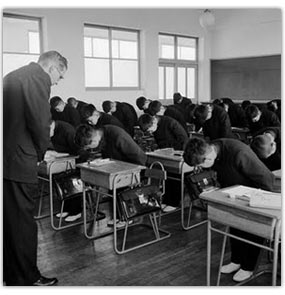One way of making sense of Japan is through the concept of kata, a word which means “form” and which describes the standard patterns one must follow in martial arts, tea ceremony and so on, although the idea can be scaled up to describe just about any formal behavior seen in Japan. One morning I was preparing to meet my students at a school I’d just started teaching at. The moment I entered the room, I was shocked to see everyone stand at the same moment, bow to me, then sit down, while one student barked, “Kiritsu…rei…chakuseki!” (“Stand up! Bow! Be seated!”) in military style. This is something that’s done in school settings at the beginning of each lesson, a sign of respect to the teacher by the students, although I’d never witnessed it firsthand before. But just because Japan has this show of respect to teachers before a lesson, followed by thanking him in one voice at the end, it doesn’t necessarily mean that real respect is happening. The bowing custom is a kata, a form that must be upheld, yet Japanese students will be just as happy to complain about a bad teacher when he’s not around as any in the U.S.

Lessons in Japanese schools start with a stylized bow to the teacher.















